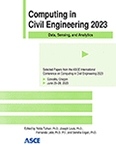Design for Disassembly in the Construction Industry: Success Factors and Computing Tools
Publication: Computing in Civil Engineering 2023
ABSTRACT
Design for disassembly (DfD) is a strategy that facilitates material recovery by proactively identifying key elements of a building that can be deconstructed in the future. Many factors influence the success of DfD, including connection type, use of lightweight components, and government policies. Many studies have focused on these factors, and several tools have been proposed to support DfD implementation. To better understand the nature of these factors and tools, this study presents a literature review composed of two parts. The first investigates critical success factors (CSFs) influencing DfD in the construction industry using a people, process, and technology (PPT) methodology. The second part focuses on DfD computer-aided tools, and the state-of-the-art in the development of these tools is discussed, along with their main contributions. In conclusion, 27 DfD critical success factors are identified along with several tools that support its implementation.
Get full access to this article
View all available purchase options and get full access to this chapter.
REFERENCES
Akanbi, L. A., Oyedele, L. O., Akinade, O. O., Ajayi, A. O., Davila Delgado, M., Bilal, M., and Bello, S. A. (2018). Salvaging building materials in a circular economy: A BIM-based whole-life performance estimator. Resources, Conservation and Recycling, 129, 175–186. https://doi.org/10.1016/j.resconrec.2017.10.026.
Akinade, O. O., Oyedele, L. O., Ajayi, S. O., Bilal, M., Alaka, H. A., Owolabi, H. A., Bello, S. A., Jaiyeoba, B. E., and Kadiri, K. O. (2017). Design for Deconstruction (DfD): Critical success factors for diverting end-of-life waste from landfills. Waste Management, 60, 3–13. https://doi.org/10.1016/j.wasman.2016.08.017.
Benachio, G. L. F., Freitas, M. D. C. D., and Tavares, S. F. (2020). Circular economy in the construction industry: A systematic literature review. Journal of Cleaner Production, 260, 121046. https://doi.org/10.1016/j.jclepro.2020.121046.
Brand. (1994). How Buildings Learn: What Happens After They’re Built. https://books.google.com/books?hl=en&lr=&id=zkgRgdVN2GIC&oi=fnd&pg=PT6&dq=How+Buildings+Learn:+What+Happens+After+They%E2%80%99re+Built&ots=2kS-8wrCFZ&sig=sQH_BBERYQ2gWFZC2LC13aK5hp4#v=onepage&q=How%20Buildings%20Learn%3A%20What%20Happens%20After%20They%E2%80%99re%20Built&f=false.
BRE. (2017). Integrated Material Profile And Costing Tool.
Cappelli, F., Delogu, M., Pierini, M., and Schiavone, F. (2007). Design for disassembly: A methodology for identifying the optimal disassembly sequence. Journal of Engineering Design, 18(6), 563–575. https://doi.org/10.1080/09544820601013019.
Crowther, P. (2005). Design for disassembly–themes and principles. Environment Design Guide, 1–7.
Dewhurst, P. (1993). Product Design for Manufacture-Design for Disassembly. Industrial Engineering, 25(9), 26–28.
Favi, C., Marconi, M., Germani, M., and Mandolini, M. (2019). A design for disassembly tool oriented to mechatronic product de-manufacturing and recycling. Advanced Engineering Informatics, 39, 62–79. https://doi.org/10.1016/j.aei.2018.11.008.
Habraken, N. J. (2000). The structure of the ordinary: Form and control in the built environment. MIT press.
Kibert, C. J., and Chini, A. R. (2000). Overview of Deconstruction in Selected Countries.
Kokkos, A. (2014). Computational Modelling tools for the promotion of Design for Deconstruction.
Rios, F. C., Chong, W. K., and Grau, D. (2015). Design for Disassembly and Deconstruction—Challenges and Opportunities. Procedia Engineering, 118, 1296–1304. https://doi.org/10.1016/j.proeng.2015.08.485.
Rocha, A., Correia, A. M., Costanzo, S., and Reis, L. P., eds. (2015). New Contributions in Information Systems and Technologies: Volume 1 (Vol. 353). Springer International Publishing. https://doi.org/10.1007/978-3-319-16486-1.
Sanchez, B., and Haas, C. (2018). A novel selective disassembly sequence planning method for adaptive reuse of buildings. Journal of Cleaner Production, 183, 998–1010. https://doi.org/10.1016/j.jclepro.2018.02.201.
Sanchez, B., Rausch, C., and Haas, C. (2019). “Deconstruction programming for adaptive reuse of buildings.” Automation in Construction, 107, 102921. https://doi.org/10.1016/j.autcon.2019.102921.
Silverstein, S. A. (2008). Applying “design for disassembly” to connection design in steel structures. Civil and Environmental Engineering.
Soh, S. L., Ong, S. K., and Nee, A. Y. C. (2014). Design for Disassembly for Remanufacturing: Methodology and Technology. Procedia CIRP, 15, 407–412. https://doi.org/10.1016/j.procir.2014.06.053.
Tingley, D. D., and Davison, B. (2011). Design for deconstruction and material reuse. Proceedings of the Institution of Civil Engineers-Energy, 164(4), 195–204.
Tingley, D. D., and Davison, B. (2012). Developing an LCA methodology to account for the environmental benefits of design for deconstruction. Building and Environment, 57, 387–395. https://doi.org/10.1016/j.buildenv.2012.06.005.
Webster, M. D., and Costello, D. T. (2005). Designing structural systems for deconstruction: How to extend a new building’s useful life and prevent it from going to waste when the end finally comes. Greenbuild Conference, Atlanta, GA, 14.
Information & Authors
Information
Published In
History
Published online: Jan 25, 2024
ASCE Technical Topics:
- Automation and robotics
- Building design
- Buildings
- Computing in civil engineering
- Construction engineering
- Construction equipment
- Construction industry
- Construction management
- Construction materials
- Construction methods
- Design (by type)
- Engineering fundamentals
- Engineering materials (by type)
- Equipment and machinery
- Facilities (by type)
- Industrial facilities
- Materials engineering
- Structural engineering
- Structures (by type)
- Systems engineering
Authors
Metrics & Citations
Metrics
Citations
Download citation
If you have the appropriate software installed, you can download article citation data to the citation manager of your choice. Simply select your manager software from the list below and click Download.
